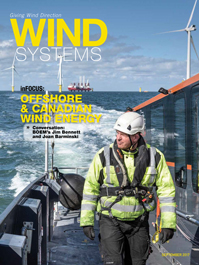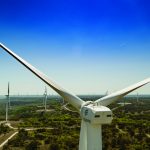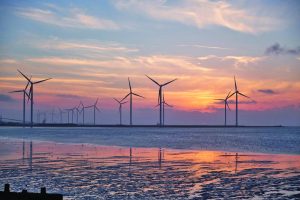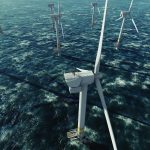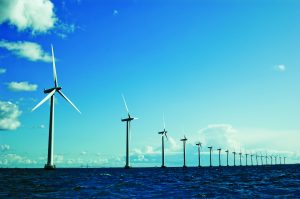Corresponding to the demands for decarbonization and diversification of energy portfolios, the offshore wind market has witnessed a commendable proliferation on a global scale. Offshore wind has traversed indeed a remarkable jaunt pertaining to its deployment, from a few megawatts of installed capacity since the first commercial scale wind farm commissioned in 2002 to a projected market volume of 60 GW by 2024. Estimates claim the global offshore wind industry size to have been recorded at more than 12 GW at the end of 2015, out of which Europe procured a major chunk of the market share.
2016 also marked another promising year for the global offshore wind market, though the total installations were approximately 31 percent down from the previous year. In 2016, a total of 2,219 MW of new offshore wind power was installed across the seven markets globally. The overall offshore wind market size in 2016 in terms of installation capacity was recorded at 14,384 MW, with an expanse of 14 markets on a global scale.

As of 2016, nearly 88 percent of the global offshore wind-power installations were in 10 European countries, and the remaining 12 percent was shared by China, Japan, South Korea, and the U.S. respectively.
Ireland, Spain, Finland, Japan, South Korea, Norway, and the U.S. are some of the other markets sharing the regional landscape of the offshore wind industry, though the current adoption trends in these economies are quite nascent.
Contemplating the trends of offshore wind market, it is undeniable that Europe will continue its dominance over the foreseeable future as well. However, with the developments in the other corners of the world, it is perceptible that the global growth of the offshore wind market has begun to take off at an appreciable pace.
Europe: The Pioneer of Offshore Wind
Europe holds the majority of offshore wind capacity and is poised to lead the regional landscape of this industry over the coming years. A plethora of factors have supported the growth trajectory of this continent. The financial backing by both the government and the private entities is one of the major factors providing a push to Europe offshore wind market. As per the statistics, over the period of 2001 to 2015, the overall RD&D expenditure in offshore wind from the public sector was approximately $1 billion to $2 billion. During the same tenure, the financial backing from the private sector was almost two to three times this valuation.

The large-scale publicly funded initiatives include the European Wind Initiative, the European Commission’s Framework Programmes, Horizon 2020, and NER300. Other bodies supporting Europe offshore wind market growth include Spain’s National Renewable Energy, Offshore Renewable Energy (ORE) Catapult, and Lindoe Offshore Renewables Center (LORC).
The cost declines commenced in 2015 with a recorded low cost of 103 euros/MWh at Danish wind farm Horns Rev 3. The trend was taken forward by the following year, 2016, when Dong Energy won a Dutch tender in June for the 760 MW Borssele 1 and 2 at 72 euros/MWh. In the same year, during September, a Danish nearshore tender was recorded at a still lower value of 64 euros/MWh. Again, the end of 2016 marked the revolutionary era for offshore wind market when Danish Kreiger’s Flak project and Borssele 3 and 4 in the Netherlands were valued at 49.90 euros/MWh and 54.50 euros/MWh during November and December.
For Europe, 2016 represented an era where offshore wind power at some instances gave a cut-throat competition to onshore, in terms of cost parameters.
The Competitive Hierarchy
In 2016, Siemens Wind Power was the chief offshore wind-turbine supplier in Europe accounting for 67.8 percent of the overall installed capacity. The second position was grabbed by MHI Vestas Offshore wind with a share of 16.4 percent. Senvion, Adwen, and BARD mark the balance of the regional landscape with a share of 6.2 percent, 5.2 percent, and 3.2 percent respectively.
In terms of new additional capacity, the top five participants securing the ownership include Northland Power — 23 percent, Dong Energy — 20.4 percent, Global Infrastructure Partners — 10.5 percent, Siemens — 7.7 percent, and Vattenfall — 7.6 percent.
With a capacity so far of more than 5 GW and 27 wind-farm installations, the U.K. is estimated to be the global leader in the offshore wind market, adding a renowned value to the overall European renewable energy landscape. A strong commitment toward decarbonization and a favorable regulatory landscape will further push the U.K. offshore wind market to evolve with the trends of clean and green energy.
With Europe deriving a major quotient of its power needs from wind energy and the continent treading with a slogan of “go-green,” it is rather undeniable that Europe will continue to maintain its dominance in the global landscape over the years ahead.
Asia and U.S.: The Emerging Contenders
Over the period of 2001 to 2015, the Asia public sector made an investment of close to $1 billion in offshore wind RD&D. The private sector in the same tenure made investments of approximately $1.5 billion.
China is expected to lead Asia offshore wind market over the coming years.
Despite having a recorded installation capacity of less than 2 GW at the end of 2015, the growth prospects for China look promising over the coming years. With a new target under the 13th Five-Year Plan to achieve an installation capacity of 10 GW by 2020, the country is poised to attain remarkable growth pertaining to offshore wind installations in the years ahead. With ongoing developments toward increasing the reliability of the offshore wind turbines, reduction in energy cost, collaboration between government entities, and favorable norms pertaining to wind-power policy systems, the China offshore wind market is expected to reach 12 GW by 2024.

Companies such as China Renewable Energy Engineering Institute, China Longyuan, and Goldwind are actively partaking in the regional offshore wind-industry growth.
Taiwan forayed into the offshore wind market with its recent announcement of installing 3 GW of offshore wind power by 2025. At present, the country has only two offshore turbines. However, the growth prospects in Taiwan are strongly driven by the fact that the region is an open market with lesser competition.
Speaking of Japan and South Korea, the regions have not shown much development with regards to offshore wind power over the past years. In the case of Japan, however, the country targets to build 1.3 GW capacity in the next 10 years with 2.5 GW under the planning category.
South Korea, addressing the country’s focus toward renewables, is estimated to build 1 GW of offshore wind capacity from 2017 to 2026.
U.S. Developments, Trends, and Prospects
2016 witnessed much awaited development in the U.S. renewables sector with the launch of the first U.S. offshore wind farm with a capacity of 30 MW. The five-turbine Block Island project was launched in December 2016 off the coast of Rhode Island. Following this launch, several other projects are in the pipeline in both state and federal waters off the Atlantic and Pacific coasts and Great Lakes. A total of 13 offshore wind projects are under multiple stages of development, as per reliable sources. The U.S. Department of Energy anticipates offshore wind to address 2 percent of the U.S. electricity demand in 2030 and 7 percent in 2050.
In March 2017, the U.S. Bureau of Ocean Energy Management and Statoil executed the lease of 321 square kilometers offshore New York. This opened up lucrative opportunities for the Norwegian giant to explore and exploit the potential of offshore wind market. Again, in May 2017, the Commonwealth’s Department of Energy Resources issued an appeal for proposals to develop 800 MW of offshore wind.

With this active participation of both the federal and state governments and the growing interests of the investors in this region, the U.S. offshore wind market is slated to witness a lucrative roadmap ahead. According to Global Market Insights, Inc., U.S. offshore wind industry held a valuation of $100 million in 2016.
To completely exploit the enormous range of opportunities ahead, the offshore wind industry must meet the growth parameters encompassing its evolution terrain. For instance, energy costs or LCOE for offshore wind should be regularly cut down to compete against the other forms of energy. Also, unlike every other industry, offshore wind market development is proportional to its expansion, penetration, and integration with other markets. For instance, the industry was earlier focused only on shallow waters, close to the shore. However, if the present scenario is considered, new innovations and technologies for different water levels and varied wind regimes are becoming an investment destination at an appreciable pace.
However, the current trends and insights of the offshore wind market assure a long-term growth horizon for its development. What remains to be seen is the turmoil the burgeoning offshore wind industry brings in the regional and competitive landscape over the years ahead.
















